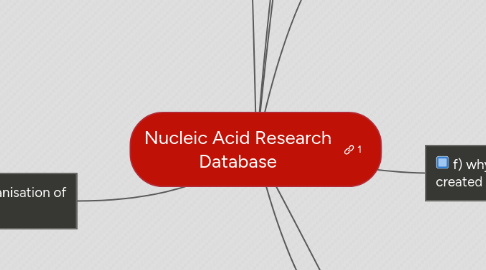
1. a)Organisation of database
1.1. a) Nucleic acid sequence & structure
1.1.1. CEGA
1.1.1.1. poorly characterized but highly conserved various group of vertebrates
1.1.2. JuncDB
1.1.2.1. exon-exon junction sequences
1.1.3. dbSuper & SEA
1.1.3.1. collect sequences of super-enhancers
1.1.3.1.1. consist of transcriptional enhancers and
1.1.3.1.2. regulate gene expression in cell&tissue
1.1.4. Dfam
1.1.4.1. database of human DNA repeat families
1.1.5. ARESite
1.1.5.1. resource on AU-rich elements invertebrate
1.1.6. NPIDB
1.1.6.1. propose a new classification DNA-protein complexes
1.1.7. JASPAR, HOCOMOCO,ORegAnno & Regulon DB
1.1.7.1. transcriptional regulation
1.1.8. BIGNAsim
1.1.8.1. DNA dynamics based on molecular dynamic stimulation
1.2. b) Protein sequence & structure
1.2.1. 1. Pfam, PANTHER, eggNOG, GPCRdb, TCDB
1.2.1.1. protein families database
1.2.2. 2. MEROPS
1.2.2.1. database of protease and protease inhibitor
1.2.3. 3. ELM, NBDB & UET
1.2.3.1. database of predicted protein functional sites
1.2.4. 4. PRIDE & dbPTM
1.2.4.1. proteomics database represented by sORF
1.2.4.1.1. collection of small ORFs identifies by ribosomes profiling
1.2.5. 5. PDBFlex
1.2.5.1. provide statistics of & animations between pairs of homologous structures in PDB
1.2.6. 6. iGNM
1.2.6.1. improved computationally flexibility information for most PDB entries
1.3. c) Metabollic & signalling pathway
1.3.1. KEGG, MetaCyc, Reactome, WikiPathways, ECMDB, BiGG Model , MNXref/ MetaNet & Metabolic Workbench
1.3.1.1. one stop repository to all kinds of metabolic data
1.3.1.1.1. includes metabolic standards, protocols, tutorial & analysis tools
1.4. d) Viruses, bacteria, protozoa & fungi
1.4.1. MG-RAST, EBI Metagenomics, probeBase & Human Pan-Microbe Communities
1.4.1.1. updates on popular metagenomics resources
1.4.2. BacWGST
1.4.2.1. simplify important task of identifying bacterial strains in sample isolated from infection
1.5. e) Genomes of human & model organism
1.5.1. DMDD
1.5.1.1. collect phenotypic data of mouse mutant embryos
1.5.2. dbMAE
1.5.2.1. manually curated data on allele-specific expression of autosomal genes
1.6. f) Human disease & drug
1.6.1. DIDA
1.6.1.1. collects data on such disease Bardet-Bledl & Kallmann syndromes
1.6.1.1.1. caused by single nucleotides variants or small indels in specific pairs of gene
1.7. g) Plants
1.7.1. CSDB & GlyTouCan
1.7.1.1. collect knowledge & facilitate further research
1.7.2. I4CR
1.7.2.1. research on rice
1.8. h) Mitochondrial & chemical compound database
1.8.1. Mitominer & Mitocanta
1.8.1.1. database of mitochondrial proteins
1.8.2. MitoAge
1.8.2.1. database of mitochondrial DNA properties from various organism
2. b) Numbers available
2.1. 1685 database
2.1.1. 88 new resources
2.1.2. 23 remove obsolette websites
3. References : 1) http://nar.oxfordjournals.org/content/44/D1/D1.full 2) http://www.ncbi.nlm.nih.gov/pmc/articles/PMC3531151/pdf/gks1297.pdf
4. e) Why some database are no longer in the database and dropped from it?
4.1. Broken link
4.2. Non-responsive website
4.3. Have been combined into large projects
4.3.1. Databases were merged into the Database of Genomic Variants (54), NAR Database Collection entry no. 655
4.3.2. NCBI’s Cancer Chromosomes database has been merged into dbVar
4.4. Commercialized and limited use as non-free version
4.4.1. Example : ExDom Database
4.5. Cut the budget of website
5. f) why databases are created and shared
5.1. easy to access the data from multiple source
5.2. a method for searching, storing and retrieving data
5.3. can search the new up-to-date information
5.4. cross-links and references to another sources
6. c) criteria for selection into NAR databases
6.1. open access to public
6.2. articles been updated monthly
6.3. provide article in html and pdf format
6.4. friendly to all level of users
6.5. information provided can be trusted and qualified
6.6. represent 5% of papers in term of originality, significance and scientific excellency
6.7. supplementary data and information can be access
6.8. compulsary
6.8.1. originality
6.8.2. show high significance level of contribution in research and study
6.8.3. high scientific impacts
